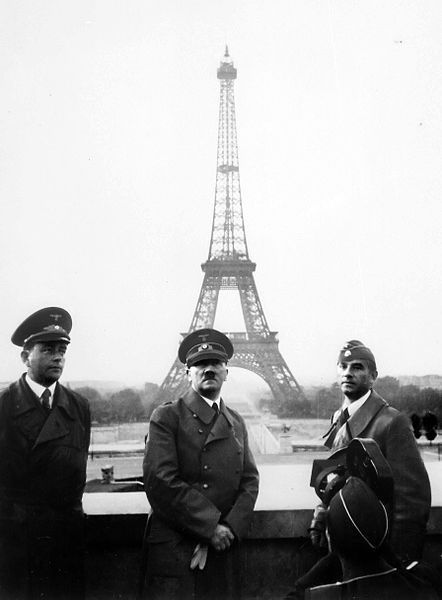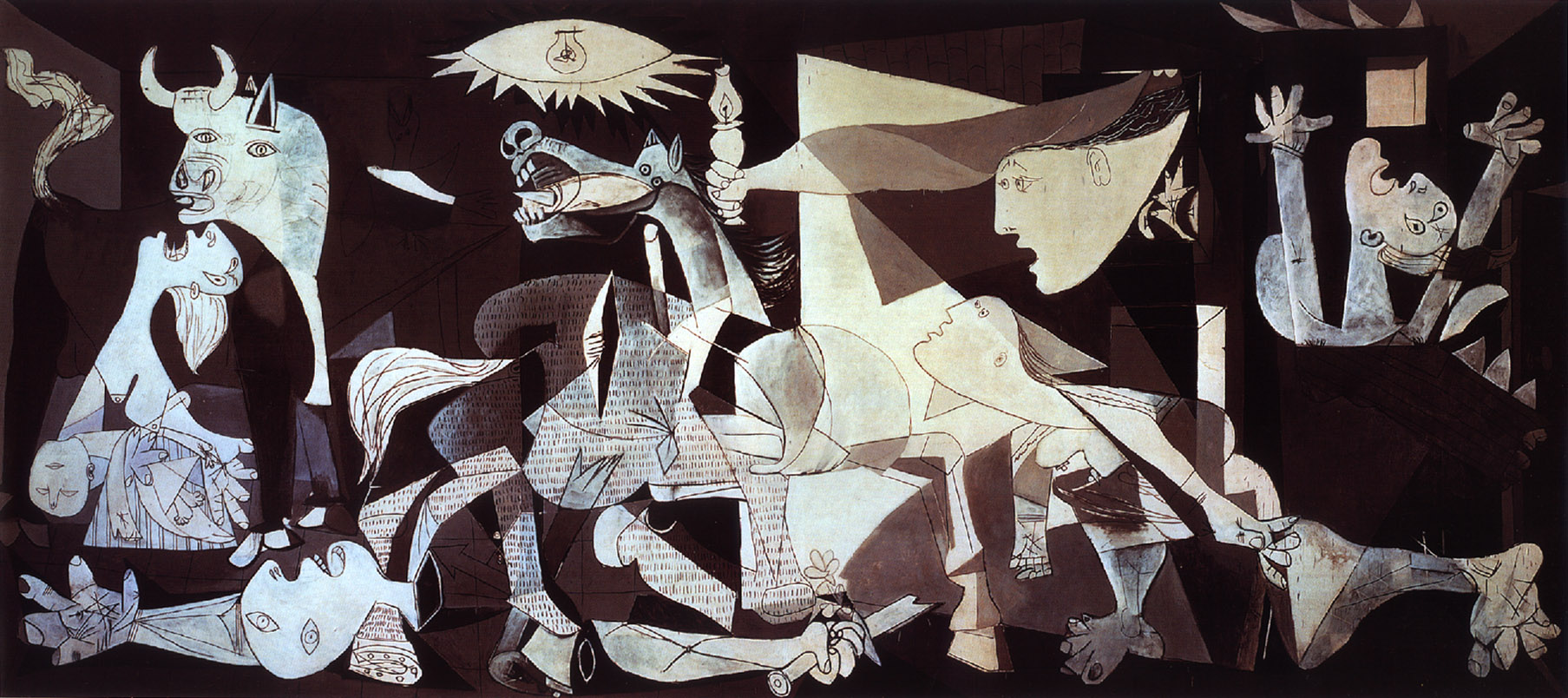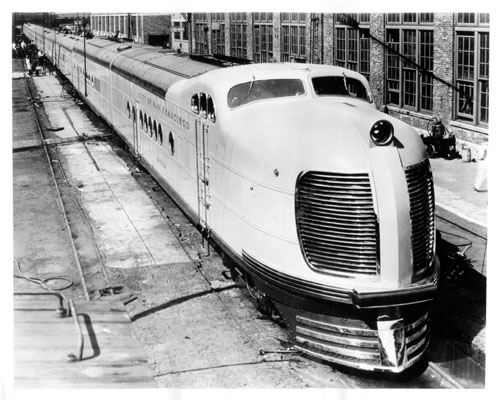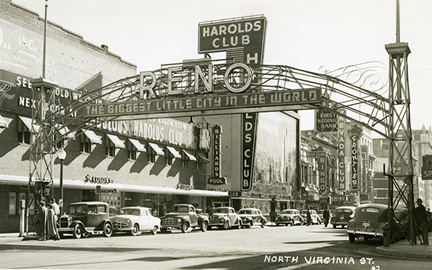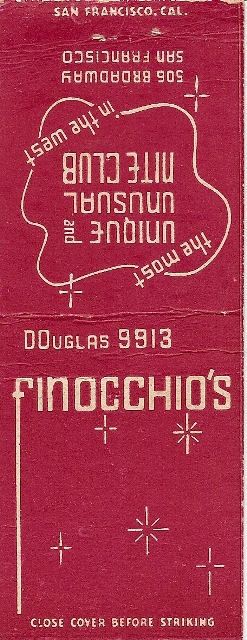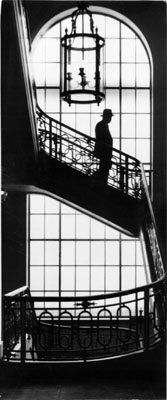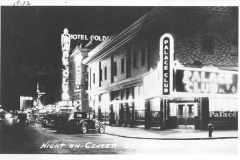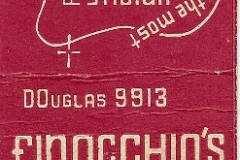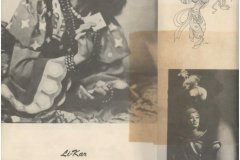City of Ghosts
“…atmospheric …captivating …full of evocative detail (the scent of Hills Brothers Coffee, the sound of Artie Shaw’s ‘Frenesi’), CITY OF GHOSTS has the vigor and pace of a terrific Warner Bros. film noir.
Tom Nolan, Wall Street Journal
“Ghost of Yesterday”, as performed by Billie Holiday. A theme song for a CITY OF GHOSTS …
Southern Pacific’s streamliner The City of San Francisco, c. 1940
Bruce Alexander Award Finalist
“…atmospheric …captivating …full of evocative detail (the scent of Hills Brothers Coffee, the sound of Artie Shaw’s ‘Frenesi’), CITY OF GHOSTS has the vigor and pace of a terrific Warner Bros. film noir.
This complex tale is set in that unsettling time before the U.S. entered World War II. It was also a time, though, of common cause and the counting of blessings. Ms. Stanley brings 1940 San Francisco to life in flamboyant language, reminiscent at times of such period prose-poets as radio’s Norman Corwin and Bay Area newspaperman Herb Caen: ‘Lying city, dying city, Lazarus and the phoenix. Wide open and proud of it, a city built on stolen sand and abandoned ships. . . . A city made by dreamers who died paupers and paupers who lived like kings.’
Miranda Corbie exemplifies her tough but beautiful town’s dualistic nature. To the idealistic State Department agent, she toasts: ‘To making a difference.’ To a dubious client, she says: ‘Bring cash . . . Checks bounce.’”
Tom Nolan, Wall Street Journal
“Stanley’s affection for San Francisco establishes a strong sense of place and time in CITY OF GHOSTS. It is, Miranda muses, ‘A city made by dreamers who died paupers and paupers who lived like kings, dreams keeping them alive in the only way that mattered.’
The author’s clear-eyed view of San Francisco and of Miranda’s character adds to the strength of the novel’s engrossing historical fiction.”
Oline Cogdill, Associated Press
“…a darkly beautiful work, one of the best to be published so far this year…. [Stanley’s wordcraft] is of a quality that is unique among the current crop of mystery and thriller authors.”
Joe Hartlaub, Bookreporter

Summer, 1940. France has fallen. Alone and isolated, only England stands in the way of Hitler.
Erstwhile escort, former Spanish Civil War nurse and now jaded private eye, Miranda Corbie takes on any and all cases to earn enough money to possibly buy passage to England … a country now under siege from the Blitzkrieg. When she recovers a socialite’s priceless jade parure—and collects a fat fee—Miranda is that much closer to her goal, finding a woman she barely remembers … her own mother.
When James MacLeod—the mysterious U.S. State Department agent who helped Miranda secure her license—shows up to collect on the debt, the promised reward takes her even closer: a possible five thousand dollars and a ticket on a ship to the United Kingdom.
The job? Spy on a University of California professor who may or may not be selling secrets to the Nazis and the Reds.
Miranda accepts the offer. And when the trail leads to art collection and art definition—to “degenerate” art and Mexican art galleries and a Picasso canvass—she warms to the espionage work, all the while dogging the mystery of her own childhood.
But then her socialite client turns up dead. Garroted. And another murder follows …
From the gilded brocade of the Nazi Consulate to Finocchio’s florid drag show, Miranda follows the trail of killers and spies and art collectors, men who will stop at nothing to own beauty. On the City of San Francisco—Art Deco streamliner heading for Chicago—she finds herself trapped in another kind of masterwork—when she’s framed for a murder she never saw coming …
CITY OF GHOSTS is a book as driven by character as it is by suspense, a novel that asks tough questions of the past that have yet to be answered in the present. Join Miranda on her journey. Noir will never be the same.
The playlist for CITY OF GHOSTS
- Fools Rush In Frank Sinatra with Tommy Dorsey and his Orchestra 3:16
- Make-Believe Island Mitchell Ayres and his Orchestra 3:13
- Traffic Jam Artie Shaw and his Orchestra 2:14
- Day In, Day Out Bob Crosby and his Orchestra 2:58
- (I've Got) That Old Feeling Martha Tilton with Benny Goodman and his Orchestra 2:28
- It's Only A Paper Moon Lee Wiley with Jess Stacy and his Orchestra 3:08
- Only Forever Bing Crosby 3:10
- Toi et Moi Maurice Chevalier 2:55
- My Future Just Passed The Boswell Sisters 3:26
- Careless Glenn Miller and his Orchestra 3:06
- Motherless Child Lee Wiley 3:15
- September In The Rain Guy Lombardo and his Orchestra 2:58
- This Is No Dream Tommy Dorsey and his Orchestra 2:41
- Maybe Bob Chester and his Orchestra 3:21
- How Am I To Know Tommy Dorsey and his Orchestra 3:11
- If It's The Last Thing I Do Tommy Dorsey and his Orchestra 2:57
- Someone To Watch Over Me Lee Wiley 2:44
- (I'm Afraid) The Masquerade Is Over Jimmy Dorsey and his Orchestra 3:16
- Little Brown Jug Glenn Miller and his Orchestra 2:51
- Smoke Gets in Your Eyes Ruth Etting 2:36
- It Had To Be You Benny Goodman and his Orchestra 2:56
- Where Or When Benny Goodman, Gene Krupa, Teddy Wilson 3:30
- Stairway To The Stars Glenn Miller and his Orchestra 2:52
- The Man I Love Lee Wiley 3:02
- Lover Come Back To Me Benny Goodman and his Orchestra 3:13
- All Or Nothing At All Frank Sinatra with Harry James and his Orchestra 3:00
- This Can't Be Love Martha Tilton with Benny Goodman and his Orchestra 2:46
- Train Whistle Blues Jimmie Rodgers 3:03
- Anything Goes Ramona Davies with Paul Whitman and his Orchestra 3:09
- Waiting For A Train Jimmie Rodgers 2:47
- Imagination Glenn Miller and his Orchestra 2:44
- Ghost Of Yesterday Billie Holiday And Her Orchestra 2:41
“Stanley’s third mystery featuring P.I. Miranda Corbie once again showcases her ability to transport the reader back in time. The atmosphere, character, dialogue and setting all feel authentic to the point that one wonders if Stanley has a device to go back in time, record events and come back to transcribe them. Fans and newcomers alike will be eager to see what happens to Miranda next.”
Jeff Ayers, RT Book Reviews (4 stars)
Miranda Corbie faces challenges on both the global and personal level in Shamus Award-finalist Stanley’s assured third noir featuring the tough-talking San Francisco PI (after 2011’s CITY OF SECRETS). In the summer of 1940, Miranda not only receives a mysterious postcard purportedly from her long-lost mother but is also courted by the government to help sniff out a Nazi spy hiding in plain sight as an art-loving University of California chemistry professor, Dr. Huntington Jasper … Along the way, corpses start popping up, and Miranda herself is even in the frame for murder. Along with her keen eye for period detail and vernacular, Stanley reminds us once again why we’d all be lucky to have Miranda Corbie in our corner.
Publishers Weekly
Once again, Kelli Stanley brings historic San Francisco to life in all its beauty and grit. Every detail is pitch-perfect in this atmospheric novel; the pre-war atmosphere, the tension, the crime. Stanley beautifully captures the uneasiness in the country, the feeling of unrest. And, then she gives us Miranda Corbie, a character as gritty as the city itself, with a disreputable past to match. And, both the city and Miranda have memories that spur them on.
Miranda can be dogged, unforgiving, and determined when it comes to finding answers. And, sometimes those memories hurt, forcing her to push away those who love her. Her determination, her need to find answers for the victims she knows is summarized beautifully. “Catherine Corbie would have to wait, but she’d waited almost thirty years already. Two clients, two murders, one of a friend. A job for the government mixing spies and art, Nazis and Mexico, chemistry and killers. She’d be alone…but Miranda was used to that.”
If you want to understand pre-war America, the looting of Europe’s art treasures, San Francisco’s history, or the story of a strong, gritty woman, a woman with a past, and a city with a past, Kelli Stanley’s CITY OF GHOSTS is a must-read.
Lesa Holstine, Lesa’s Book Critiques
Kelli reads from Chapter One of CITY OF GHOSTS
Kelli reads the opening chapter, which finds Miranda in a Chinatown pawn shop.
The World of City of Ghosts …
San Francisco to Reno, follow the footsteps of Miranda Corbie …
In CITY OF GHOSTS, Miranda Corbie wanders farther afield than we’ve seen in previous books. She revisits her old haunts—including a memorable opening encounter at a Chinatown pawn shop—and treks to the Veterans Building in Civic Center to attend the opening night of an art exhibition at the San Francisco Museum of Art.
While Yick Lung is now longer a part of Chinatown’s labyrinth of alleyways, it doesn’t take too much imagination to envision it, and the Veterans Building still stands, Beaux Arts testament to the men who fought the Great War. Of course, the San Francisco Museum of Art is now the San Francisco Museum of Modern Art, housed in an architecturally significant building south of Market Street.
Miranda returns to the Club Moderne … and crashes a Nazi costume ball held at the German Consulate. The building that displayed the swastika for a number of years is still extent and visible on a walk down Market Street.
Finocchio’s was the most famous drag club in America for most of the 20th century and Miranda pays it a memorable visit. Alas, the club is gone, victim of high rents, YouTube and the 21st century. You can still see the building, however, on a walk through North Beach. Be sure to stop in for a pizza at Lupo’s (now Tommaso’s), the oldest pizzeria in San Francisco.
Miranda takes an Interurban Railway car to a much-changed University of California … the East Bay was a working class environment then, especially along the waterfront. Berkeley was still a preeminent research university, but far, far away from the Summer of Love.
The now defunct Bay Bridge takes her to Treasure Island and, later, back to the Ferry Building for a train ticket. The Southern Pacific streamliner “City of San Francisco” was the fastest and most luxurious railroad on the tracks … and Miranda must follow her quarry wherever the trail leads, including Reno, Nevada, the Biggest Little City in the World … and one of the most dangerous.
Follow Miranda on a dangerous and thrilling journey … but watch out for the ghosts.
“Cities of Sin”
Reno, Nevada. The Biggest Little City in the World.
Where anything goes, where women drift in for a six-week “cure” … and never come home.
In San Francisco, Finocchio’s is a city within a city like Chinatown, a nightclub starring beautiful women who happen to have been born male, a tourist attraction and a haven … when cross-dressing was a criminal offense.
San Francisco’s naughty, bawdy days have never been fully behind her. By 1940, she’d built a veneer of respectability that was as transparent as the cowgirl costumes at Sally Rand’s Ranch. Finocchio’s in North Beach catered to tourists and locals alike, offering an eye-popping array of male-as-female entertainment that—were it found on Market Street—would find the performer arrested for “indecency.”
Sister city Reno was more straight-forward, promoting gambling and prostitution as a state-run, tax-generating business—though cross-dressing was still illegal. Vice meant money, and there was plenty of both to go around while women waited for a divorce in the Biggest Little City in the World. Miranda finds more than she bargained for in these profitable “cities of sin” …
The Streamliner
In the first two-thirds of the 20th Century, people traveled by train. The railroad was the fabric of American life; not only the standard method of transportation for goods and people, but a symbol of American expansionism and the fast-disappearing myth of the West.
By 1939, the new, modern class of Streamliner was an Art Deco-styled engineering marvel, modeled on the great ocean liners of the period, a luxury ship that sailed over the rails like the SS Normandie plowed through waves.
No individual train was more famous—or infamous—than the City of San Francisco.
Born in 1936, and operated by three different railroad companies between San Francisco and Chicago (Southern Pacific, Union Pacific, and Chicago and Northwestern Railway), she was the fastest thing on the rails, and the Southern Pacific’s most famous train.
She was synonymous with white glove and top hat travel … fast, modern, beautiful and, above all, luxurious. Sleek and sinuous, gleaming with chrome and color, she was also competing with the image of the “Old West” train, the coal and diesel big-hearted railroads that spoke eloquently to American myth and nostalgia, and on which much of the country still relied.
Railroad companies designed and marketed these trains not as trains, but rather as ocean liners on land, more akin to the great ships of Cunard and Matson than her lowly iron brethren: even the trips the City of San Francisco made across the rugged West were termed “sailings”. This was the hook used to sell the idea of the streamliner, until her day, too, passed into twilight.
On August 12, 1939, in the desolate desert landscape outside Harney, Nevada, the pride of Southern Pacific’s fleet derailed. Cars in the nearly quarter-mile long train consist were smashed and crumpled like aluminum toys, sent over an embankment and into the Humboldt River. 24 people died; 121 were injured. Five cars were totaled.
Southern Pacific claimed it was sabotage; disgruntled workers or even Nazi spies had moved a rail and forced the train off the tracks. Eventually, over twenty men were arrested but never charged. The fact that train passengers had experienced abnormally high speed leading up to the accident—and that the engineer told the fireman he’d make up a 26 minute delay by throttling across Nevada—was found not to be a factor …in an inquiry conducted by Southern Pacific itself.
The case has never been officially solved. Whether brought about by sabotage or speed, it is this tragic accident to which Miranda refers in CITY OF GHOSTS.
The days of rapid yet luxurious travel are far behind us. Where once the mighty railroads plowed through snow and ice and ran like quicksilver down mountain valleys, are now freeways and tollways. The airplane supplanted the train, and economy supplanted luxury.
Amtrak is still here, though; in fact, much of the route of the City of San Francisco is still intact, a memorable train ride waiting to be recreated.
Even one of the former cars—the “Civic Center”—is still extant, sitting on the tracks at the Millbrae Train Museum outside of San Francisco. If you’re ever in the Bay Area, stop by for a visit.
Exterminating Culture
The Nazis proved that mass murder begins with social marginalization; the eviction of diversity from the social order, the foreboding and ultimately fatal stamp of “the other.”
Books, music, plays, film and fine art were no more immune to this concept than the millions upon millions of human victims in the Holocaust.
“Degenerate” Art or entartete Kunst was the term for banned works that the regime labeled “depraved” or “degenerate” because of “Jewish” or “Jewish-Communist” authorship or “influence” … a label that encompassed, according to Nazi policy, nearly all modern art from Impressionism forward, particularly those artistic movements identified with the hated Weimar Republic. Germany, according to law and Der Fuehrer’s own tastes, must be purged of all such “decadent” influence.
Hitler—the failed, mediocre art student—completed his revenge.
Above, a video on Nazi book burnings from the U.S. Holocaust Museum.
While it was illegal to import “degenerate” art into Germany, it was perfectly legal to buy—or “confiscate” it, if you were a Nazi official—in France. But what of the vast holdings of art treasures that did not qualify as modern and therefore “degenerate”? What of masterworks of Greece and Rome, the Middle Ages and works by artists like Rembrandt, Cranach and Vermeer?
As Germany became more and more isolated, art became currency, not only for those trying to escape persecution, as it had been earlier in the war, but for individuals seeking to survive the inevitable end of the Third Reich. And, as always, Hitler and Goring competed at the highest levels for “ownership” of Nazi-approved masterworks by favored artists like Vermeer.
The most valuable works, ironically, were often kept by high ranking Nazi officials like Herman Goring, who plucked a Cezanne and a Van Gogh from the “degenerate” art trash heap.
entartete Kunst
All “degenerate” work was confiscated from museums and collections by 1937, when Joseph Goebbels (Reich Minister for Public Entertainment and Propaganda) and Adolf Ziegler (Reich Chamber of Visual Art) decided to exhibit the confiscated pieces to the public and solidify public sentiment against the “contamination.”
Many of the paintings were hung upside down, crowded and purposefully displayed in as chaotic a fashion as possible to emphasize their “degeneracy” to the millions who flocked to see the show. Hate speech and “critiques” were painted on the walls next to the artwork. Below is a video of the 1937 Munich Exhibition.
Of course, the value of much of this work still held outside of Nazi Germany and the fascist government took full advantage of this fact. In June, 1939, some of the more priceless pieces from the exhibit were auctioned off in Switzerland by the Galerie Fischer (still in business, by the way), an event that garnered great interest worldwide from museums and private collectors. Below, a selection of “Degenerate Art”.
no images were found
Lost and Found
High ranking Nazis and collaborators looted, hoarded and stashed thousands upon thousands of European treasures, from altar pieces to the Mona Lisa to silver liturgical pieces. But much European artistic patrimony—especially from Poland—was systematically destroyed.
A good deal will never be recovered, though efforts have been in place for a number of years to identify artwork looted from individuals so that it can be repatriated back to the heirs of the original owners. Below are some of the artworks rescued by the real-life Monuments Men.
no images were found
Below are ten looted masterworks out of thousands that are still missing: some presumably destroyed, some in forgotten hiding places, and some hoarded and possessed by private “collectors” … a true definition of “degenerate”, if you will.
In fact, approximately four thousand condemned entartete Kunst paintings, drawings, prints, etc. were destroyed by the Berlin Fire Brigade in 1939 because they were not deemed valuable enough for the international market. In 1942, more were burned (this time works by Picasso, Miro, Dali, Klee, Leger, and Ernst) at the Jeu de Paume in Paris.
no images were found


